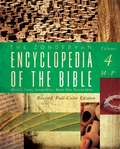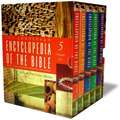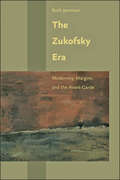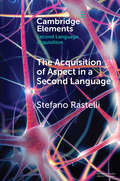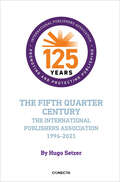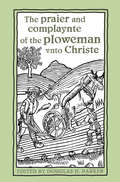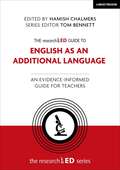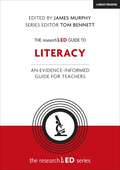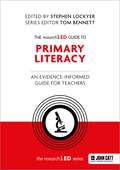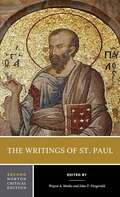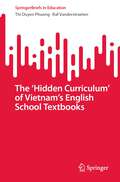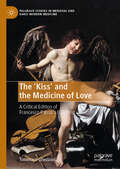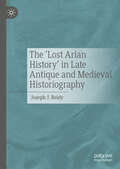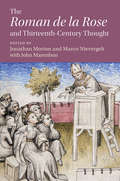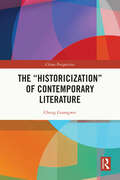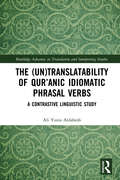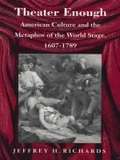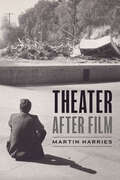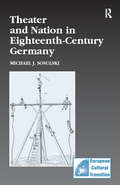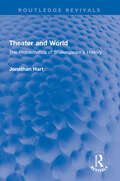- Table View
- List View
The Zondervan Encyclopedia of the Bible, Volume 4: Revised Full-Color Edition
by Moisés Silva Merrill C. TenneyRevised edition. Volume 4 of 5. The Zondervan Encyclopedia of the Bible has been a classic Bible study resource for more than thirty years. Now thoroughly revised, this new five-volume edition provides up-to-date entries based on the latest scholarship. Beautiful full-color pictures supplement the text, which includes new articles in addition to thorough updates and improvements of existing topics. Different viewpoints of scholarship permit a wellrounded perspective on significant issues relating to doctrines, themes, and biblical interpretation. The goal remains the same: to provide pastors, teachers, students, and devoted Bible readers a comprehensive and reliable library of information. • More than 5,000 pages of vital information on Bible lands and people • More than 7,500 articles alphabetically arranged for easy reference • Hundreds of full-color and black-and-white illustrations, charts, and graphs • 32 pages of full-color maps and hundreds of black-and-white outline maps for ready reference • Scholarly articles ranging across the entire spectrum of theological and biblical topics, backed by the most current body of archaeological research • 238 contributors from around the world
The Zondervan Encyclopedia of the Bible, Volume 5: Revised Full-Color Edition
by Moisés Silva Merrill C. TenneyRevised edition. Volume 5 of 5. The Zondervan Encyclopedia of the Bible has been a classic Bible study resource for more than thirty years. Now thoroughly revised, this new five-volume edition provides up-to-date entries based on the latest scholarship. Beautiful full-color pictures supplement the text, which includes new articles in addition to thorough updates and improvements of existing topics. Different viewpoints of scholarship permit a wellrounded perspective on significant issues relating to doctrines, themes, and biblical interpretation. The goal remains the same: to provide pastors, teachers, students, and devoted Bible readers a comprehensive and reliable library of information. • More than 5,000 pages of vital information on Bible lands and people • More than 7,500 articles alphabetically arranged for easy reference • Hundreds of full-color and black-and-white illustrations, charts, and graphs • 32 pages of full-color maps and hundreds of black-and-white outline maps for ready reference • Scholarly articles ranging across the entire spectrum of theological and biblical topics, backed by the most current body of archaeological research • 238 contributors from around the world
The Zukofsky Era: Modernity, Margins, and the Avant-Garde (Hopkins Studies in Modernism)
by Ruth JennisonZukofsky, Oppen, and Niedecker wrote with a diversity of formal strategies but a singularity of purpose: the crafting of an anticapitalist poetics.Inaugurated in 1931 by Louis Zukofsky, Objectivist poetry gave expression to the complex contours of culture and politics in America during the Great Depression. This study of Zukofsky and two others in the Objectivist constellation, George Oppen and Lorine Niedecker, elaborates the dialectic between the formal experimental features of their poetry and their progressive commitments to the radical potentials of modernity.Mixing textual analysis, archival research, and historiography, Ruth Jennison shows how Zukofsky, Oppen, and Niedecker braided their experiences as working-class Jews, political activists, and feminists into radical, canon-challenging poetic forms. Using the tools of critical geography, Jennison offers an account of the relationship between the uneven spatial landscapes of capitalism in crisis and the Objectivists’ paratactical textscapes. In a rethinking of the overall terms in which poetic modernism is described, she identifies and assesses the key characteristics of the Objectivist avant-garde, including its formal recognition of proliferating commodity cultures, its solidarity with global anticapitalist movements, and its imperative to develop poetics that nurtured revolutionary literacy. The resulting narrative is a historically sensitive, thorough, and innovative account of Objectivism’s Depression-era modernism.A rich analysis of American avant-garde poetic forms and politics, The Zukofsky Era convincingly situates Objectivist poetry as a politically radical movement comprising a crucial chapter in American literary history. Scholars and students of modernism will find much to discuss in Jennison’s theoretical study.
The [european] Other In Medieval Arabic Literature And Culture
by Nizar F. HermesContrary to the monolithic impression left by postcolonial theories of Orientalism, the book makes the case that Orientals did not exist solely to be gazed at. Hermes shows that there was no shortage of medieval Muslims who cast curious eyes towards the European Other and that more than a handful of them were interested in Europe.
The acquisition of aspect in a second language (Elements in Second Language Acquisition)
by Stefano RastelliThe acquisition of the aspect is a central area in Second Language Acquisition research, the subject of hundreds of papers and dozens of edited volumes, monographs and special issues. This introduction provides the reader not only with a concise and plain presentation of the main hypotheses advanced in the past, but also with an overview of contemporary research. Stefano Rastelli shows how comparison of behavioural (production-comprehension), processing and statistical data is improving - and partially changing - our understanding of how learners acquire the aspectual distinctions of the target-language.
The fifth quarter century: The International Publishers Association 1996-2021
by Hugo SetzerTHE INTERNATIONAL PUBLISHERS ASSOCIATION IPA) is the world's largest federation of national, regional and specialist publishers' associations. Through its members, IPA represents thousands of individual publishers around the world who service markets containing more than 5.6 billion people. Based in Geneva, Switzerland, IPA represents the interests of the publishing industry in international fora and wherever publishers' interests are at stake.
The literature of Al-andalus
by Michael Sells Raymond P. Scheindlin María Rosa MenocalThe Literature of Al-Andalus is an exploration of the culture of Iberia, present-day Spain and Portugal, during the period when it was an Islamic, mostly Arabic-speaking territory, from the eighth to the thirteenth century, and in the centuries following the Christian conquest when Arabic continued to be widely used. The volume embraces many other related spheres of Arabic culture including philosophy, art, architecture and music. It also extends the subject to other literatures - especially Hebrew and Romance literatures - that burgeoned alongside Arabic and created the distinctive hybrid culture of medieval Iberia. Edited by an Arabist, an Hebraist and a Romance scholar, with individual chapters compiled by a team of the world's leading experts of Islamic Iberia, Sicily and related cultures, this is a truly interdisciplinary and comparative work which offers a interesting approach to the field.
The politics of Harry Potter
by Bethany BarrattThis political analysis of Harry Potter uses the beloved wizarding world to introduce readers to the equally murky and intimidating world of politics. Rowling's work provides us with entries into all of the most important political questions in history, from terrorism and human rights to the classic foundations of political thought.
The praier and complaynte of the ploweman unto Christe
by Douglas H. ParkerSixteenth-century English Protestant reformers were hard-pressed to establish a historical pedigree that would provide their ideas with weight and legitimacy. Many of those reformers turned back to early fifteenth-century Lollard texts, recycling and reprinting them to serve the needs, both political and spiritual, of the burgeoning English Protestant reform movement. The anti-clerical and reformist Lollard text, The praier and complaynte of the ploweman vnto Christe, was one of the works used by sixteenth century English Protestants in their struggle for religious reform. This is an old-spelling, critical edition of the version of The praier and complaynte of the ploweman vnto Christe that resurfaced in the 1530s. Demonstrating the continuity of ideas between the Lollards and the Reformists, Douglas Parker situates The praier and complaynte firmly in the tradition of English Reformist borrowing of texts, and argues for William Tyndale as editor of the sixteenth-century version of The praier and complaynte. Parker examines the two extant copies of the manuscript, and comments on the work's structure and reformist content. He presents full historical, literary, and biographical information in his introduction, and a full line-by-line commentary on the text.This careful, meticulous work is a revealing look at the ideology of Protestant religious struggles in England from the fourteenth to the sixteenth century.
The researchED Guide to English as an Additional Language: An evidence-informed guide for teachers (researchED)
by Tom Bennett Hamish ChalmersIn this edition, Hamish Chalmers provides a primer on the key questions teachers and researchers have about the education of children learning English as an Additional Language (EAL). From the general implications of teaching children in a language that many are still in the process of learning, to the specifics of EAL-friendly pedagogy, this volume includes contributions from both teachers and researchers in the field: Victoria Murphy, Constant Leung, Jonathan Bifield, Feyisa Demie, Ann-Margaret Smith, Naomi Flynn, Holly Joseph, Tracey Costley, Xiao Lan Curdt-Christiansen, and Eowyn Crisfield.Hamish Chalmers is a lecturer and EAL researcher at the University of Oxford, vice-chair of NALDIC — the UK’s EAL subject association — and erstwhile primary school teacher, both in the UK and overseas.
The researchED Guide to English as an Additional Language: An evidence-informed guide for teachers (researchED)
by Tom Bennett Hamish ChalmersIn this edition, Hamish Chalmers provides a primer on the key questions teachers and researchers have about the education of children learning English as an Additional Language (EAL). From the general implications of teaching children in a language that many are still in the process of learning, to the specifics of EAL-friendly pedagogy, this volume includes contributions from both teachers and researchers in the field: Victoria Murphy, Constant Leung, Jonathan Bifield, Feyisa Demie, Ann-Margaret Smith, Naomi Flynn, Holly Joseph, Tracey Costley, Xiao Lan Curdt-Christiansen, and Eowyn Crisfield.Hamish Chalmers is a lecturer and EAL researcher at the University of Oxford, vice-chair of NALDIC — the UK’s EAL subject association — and erstwhile primary school teacher, both in the UK and overseas.
The researchED Guide to Literacy: An evidence-informed guide for teachers (researchED)
by James Murphy Tom BennettresearchED is an educator-led organisation with the goal of bridging the gap between research and practice. This accessible and punchy series, overseen by founder Tom Bennett, tackles the most important topics in education, with a range of experienced contributors exploring the latest evidence and research and how it can apply in a variety of classroom settings.In this edition, James Murphy examines the latest evidence surrounding student literacy, editing contributions from a wide range of writers.
The researchED Guide to Primary Literacy: An evidence-informed guide for teachers
by Stephen LockyerresearchED is an educator-led organisation with the goal of bridging the gap between research and practice. This accessible and punchy series, overseen by founder Tom Bennett, tackles the most important topics in education, with a range of experienced contributors exploring the latest evidence and research and how it can apply in a variety of classroom settings.Literacy is one of the most powerful and transformative learning tools: making changes and improvements in Literacy will have a direct impact on your work, your learning and your aspirations across all subjects in the curriculum.In this book, Stephen Lockyer brings together contributions from expert writers, including Clare Sealy, Emma Stokes, Neil Almond and Andrew Percival, to show how making tiny, incremental changes with consistency and genuine purpose can have a big effect on your students, their literacy, and their learning. Each chapter has an abundance of ideas to take into your classroom and have a direct impact on the pupils.
The researchED Guide to Primary Literacy: An evidence-informed guide for teachers
by Stephen LockyerresearchED is an educator-led organisation with the goal of bridging the gap between research and practice. This accessible and punchy series, overseen by founder Tom Bennett, tackles the most important topics in education, with a range of experienced contributors exploring the latest evidence and research and how it can apply in a variety of classroom settings.Literacy is one of the most powerful and transformative learning tools: making changes and improvements in Literacy will have a direct impact on your work, your learning and your aspirations across all subjects in the curriculum.In this book, Stephen Lockyer brings together contributions from expert writers, including Clare Sealy, Emma Stokes, Neil Almond and Andrew Percival, to show how making tiny, incremental changes with consistency and genuine purpose can have a big effect on your students, their literacy, and their learning. Each chapter has an abundance of ideas to take into your classroom and have a direct impact on the pupils.
The writings of St Paul Annotated Texts, Reception and Criticism 2nd edition
by Wayne A. Meeks John T. Fitzgerald Saint PaulThe Second Edition of this perennially popular Norton Critical Edition is based on the Today’s New International Version of Paul’s letters, a new translation that is heralded for its inclusiveness and accuracy in representation of gender. This thoroughly revised and expanded edition includes an entirely new introduction to Paul and the central issues surrounding his writings, as well as several newly included sections of writings from Paul’s time to the present, among them “Annotated Text: Pseudo-Pauline Writings”; “The Apocryphal Paul: Some Early Christian Traditions and Legends,” with writings by Jerome, Clement of Alexandria, Ambrosiaster, and others; “The Martyrdom of Paul”; “Paul and His Pagan Critics;” “Valentinus and the Gnostic Paul,”with writings by Theodotus and Elaine Pagels; “Paul and the Christian Martyrs”; “A Sampler of Patristic Interpretations”; “The Second Century Paul”; “Reading Romans,” with writings from Origen, Theodoret of Cyrus, Paul W. Meyer, Stanley Stowers, Ernst Käsemann, and others; and “A Sampler of Modern Approaches to Paul and His Letters,” with writings by Elisabeth Schüssler Fiorenza, Abraham J. Malherbe, Peter Lampe, Margaret M. Mitchell, and Dale B. Martin. A helpful Epilogue―“The Christian Proteus,” by Wayne A. Meeks―a Selected Bibliography, and an Index are also included.
The ‘Hidden Curriculum’ of Vietnam’s English School Textbooks (SpringerBriefs in Education)
by Raf Vanderstraeten Thi Duyen PhuongThis book analyzes the basic ideas and premises underlying the English textbooks used at the higher secondary school level in Vietnam from the 1980s to the present, from a sociological perspective. The dataset, upon which this book builds, consists of a collection of 18 textbooks, which belong to five sets of locally developed English textbooks for grade 10 to grade 12 students. These series were used in all public schools from the mid-1980s to the present. During this period, schooling expanded rapidly in Vietnam, while English also gained increasing prominence within the school system.This book examines the curricular content of these textbooks and presents a long-term analysis of the ‘hidden’ curricular content in light of Vietnam’s recent history and its government’s concerns about national identity.
The ‘Kiss’ and the Medicine of Love: A Critical Edition of Francesco Patrizi’s Il Delfino (Palgrave Studies in Medieval and Early Modern Medicine)
by Tommaso GhezzaniThis is a revised critical edition of philosopher and scientist, Francesco Patrizi's manuscript, Il Delfino, overo del bacio (c.1555), with an English translation and commentary. Il Delfino, or ‘The Kiss’ survives in a single manuscript, compiled by an assistant and interspersed with autograph corrections by Patrizi himself. The only modern critical edition of the text, edited by Danilo Aguzzi Barbagli (1975), is known to contain many errors that prevent a correct understanding of the work. This book therefore fills this historiographical gap and at the same time provides a reliable text for further translations of Patrizi's work into other languages.
The ‘Lost Arian History’ in Late Antique and Medieval Historiography
by Joseph J. ReidyThis book explores the writing of church history during the early Byzantine period, reconsidering the evidence for the nature and authorship of a hypothetical 'Arian' source for many surviving medieval histories of the fourth century. It considers surviving ecclesiastical histories written between the fifth and early thirteenth centuries to draw out commonalities apparently owed to this 'lost' source and discusses attempts by modern historians to reconstruct it. In doing so, it convincingly argues that this 'Arian' material likely belongs not to one work, but three: two chronicles and a martyrology. This book therefore provides a vital reassessment of fourth-century Christian historiography, as well as important insights on chronicle writing in the Middle Ages.
The ‘Roman de la Rose' and Thirteenth-Century Thought (Cambridge Studies in Medieval Literature #111)
by Jonathan Morton Marco NievergeltThe thirteenth-century allegorical dream vision, the Roman de la Rose, transformed how medieval literary texts engaged with philosophical ideas. Written in Old French, its influence dominated French, English and Italian literature for the next two centuries, serving in particular as a model for Chaucer and Dante. Jean de Meun's section of this extensive, complex and dazzling work is notable for its sophisticated responses to a whole host of contemporary philosophical debates. This collection brings together literary scholars and historians of philosophy to produce the most thorough, interdisciplinary study to date of how the Rose uses poetry to articulate philosophical problems and positions. This wide-ranging collection demonstrates the importance of the poem for medieval intellectual history and offers new insights into the philosophical potential both of the Rose specifically and of medieval poetry as a whole.
The “Historicization" of Contemporary Literature (ISSN)
by Cheng GuangweiThis book provides a concise introduction to the intellectual trends in contemporary Chinese literature from the 1950s to the 1990s and the influence of overseas Sinology.The turbulent period of the second half of the 20th century in China witnessed a significant societal shift from a revolutionary to an economic focus. This transformation introduced and stimulated various ideas, reshaping public thought and reconstructing the historical landscape of contemporary Chinese literature. This book explores the response and self-exploration of domestic literary studies of the period, which were heavily influenced by the Western academic tradition and overseas Sinology studies. It examines critical phenomena, figures, and events in this context. The author's narrative vividly illustrates the interplay and dialogue of factors such as revolution, reform and opening up, and the rise of literature in the 1980s and 1990s. Combining the methodologies of literary and social history, and integrating personal historical experience with rigorous academic methods, this book provides a unique research framework for revisiting the cultural scene of the period.The title will appeal to scholars and students of contemporary Chinese literature and history. It will also attract general readers interested in Chinese culture and society in the 1980s and 1990s.
The: A Contrastive Linguistic Study (Routledge Advances in Translation and Interpreting Studies)
by Ali Yunis AldaheshQur’anic idiomaticity, in its all aspects, poses a great deal of challenge to Qur’an readers, learners, commentators, and translators. One of the most challenging aspects of Qur’anic idiomaticity is Qur’anic idiomatic phrasal verbs, where significances of proper Arabic verbs are entirely fused with significances of prepositions following them to produce new significances that have nothing to do with the basic significances of those verbs and prepositions. By examining a corpus of ten of the most influential English translations of the Qur’an, this study scrutinizes how some translators of the Qur’an have dealt with the phenomenon of Qur’anic idiomatic phrasal verbs, the difficulties that they have encountered when translating them into English, and the strategies that they have employed in their attempts to overcome the inherent ambiguity of such expressions and provide their functional-pragmatic equivalents for English readership. The study proposes a working model for analysing and assessing the translation of the Qur’anic idiomatic phrasal verbs and provides a number of theory-based recommendations for translators in general and Qur’an translators in particular.
Theater Enough: American Culture and the Metaphor of the World Stage, 1607–1789
by Jeffrey H. RichardsThe early settlers in America had a special relationship to the theater. Though largely without a theater of their own, they developed an ideology of theater that expressed their sense of history, as well as their version of life in the New World. Theater Enough provides an innovative analysis of early American culture by examining the rhetorical shaping of the experience of settlement in the new land through the metaphor of theater.The rhetoric, or discourse, of early American theater emerged out of the figures of speech that permeated the colonists' lives and literary productions. Jeffrey H. Richards examines a variety of texts--histories, diaries, letters, journals, poems, sermons, political tracts, trial transcripts, orations, and plays--and looks at the writings of such authors as John Winthrop and Mercy Otis Warren. Richards places the American usage of theatrum mundi--the world depicted as a stage--in the context of classical and Renaissance traditions, but shows how the trope functions in American rhetoric as a register for religious, political, and historical attitudes.
Theater after Film
by Martin HarriesA study of the impact of film and mass culture on drama after World War II. In Theater after Film, Martin Harries argues that after 1945, as cinema became omnipresent in popular culture, theater had to respond to cinema’s hegemony. Theater couldn’t break that hegemony, but it could provide a zone of contestation. Theater made film’s domination of the cultural field visible through hyperbole, refusal, and other strategies, thereby unsettling its power. Postwar theatrical experiment, Harries shows, often channeled and represented film’s mass cultural force, while knowing that it could never possess that force. Throughout the book, Harries brings critical theory into contact with theories of performance. Although Theater after Film treats the theatrical work of many figures, its central focus falls on Tennessee Williams, Samuel Beckett, and Adrienne Kennedy. Discussions of these dramatists consider their ways of addressing spectators, the politics of race between film and theater, and the place of the theatrical apparatus. Readings of these central figures in twentieth-century theater exemplify the book’s historical engagement with the media surround that drama confronted. This confrontation, Harries shows, was central to the development of some of the most continually compelling postwar drama.
Theater and Nation in Eighteenth-Century Germany (Studies in European Cultural Transition)
by Michael J. SosulskiIn 1767, more than a century before Germany was incorporated as a modern nation-state, the city of Hamburg chartered the first Deutsches Nationaltheater. What can it have meant for a German playhouse to have been a national theater, and what did that imply about the way these theaters operated? Michael Sosulski contends that the idea of German nationhood not only existed prior to the Napoleonic Wars but was decisive in shaping cultural production in the last third of the eighteenth century, operating not on the level of popular consciousness but instead within representational practices and institutions. Grounding his study in a Foucauldian understanding of emergent technologies of the self, Sosulski connects the increasing performance of body discipline by professional actors, soldiers, and schoolchildren to the growing interest in German national identity. The idea of a German cultural nation gradually emerged as a conceptual force through the work of an influential series of literary intellectuals and advocates of a national theater, including G. E. Lessing and Friedrich Schiller. Sosulski combines fresh readings of canonical and lesser-known dramas, with analysis of eighteenth-century theories of nationhood and evolving acting theories, to show that the very lack of a strong national consciousness in the late eighteenth century actually spurred the emergence of the German Nationaltheater, which were conceived in the spirit of the Enlightenment as educational institutions. Since for Germans, nationality was a performed identity, theater emerged as an ideal space in which to imagine that nation.
Theater and World: The Problematics of Shakespeare's History (Routledge Revivals)
by Jonathan HartFirst published in 1992, Theater and World is a detailed exploration of Shakespeare’s representation of history and how it affects the relation between theatre and world. The book focuses primarily on the Second Tetralogy (Richard II, Henry IV Part I, Henry IV Part II, and Henry V) and includes a wealth of analysis and interpretation of the plays. In doing so, it explores a wide range of topics, including the relation between literary and theatrical representations and the world; the nature of illusion and reality; genre; the connection between history and fiction (especially plays); historiography and literary criticism or theory; poetry and philosophy; and irony, both rhetorical and philosophical. Theater and World continues to have lasting relevance for anyone with an interest in Shakespeare’s words and his representation of history in particular.
